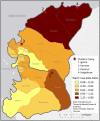Spatial distribution of suspected and confirmed cholera cases in Mwanza City, Northern Tanzania
- PMID: 36962896
- PMCID: PMC10022096
- DOI: 10.1371/journal.pgph.0001261
Spatial distribution of suspected and confirmed cholera cases in Mwanza City, Northern Tanzania
Abstract
Cholera, which is caused by Vibrio cholerae, persists as a devastating acute diarrheal disease. Despite availability of information on socio-cultural, agent and hosts risk factors, the disease continues to claim lives of people in Tanzania. The present study explores spatial patterns of cholera cases during a 2015-16 outbreak in Mwanza, Tanzania using a geographical information system (GIS) to identify concentrations of cholera cases. This cross-sectional study was conducted in Ilemela and Nyamagana Districts, Mwanza City. The two-phase data collection included: 1) retrospectively reviewing and capturing 852 suspected cholera cases from clinical files during the outbreak between August, 2015, and April, 2016, and 2) mapping of residence of suspected and confirmed cholera cases using global positioning systems (GPS). A majority of cholera patients were from Ilemela District (546, 64.1%), were males (506, 59.4%) and their median age was 27 (19-36) years. Of the 452 (55.1%) laboratory tests, 352 (77.9%) were confirmed to have Vibrio cholerae infection. Seven patients (0.80%) died. Cholera cases clustered in certain areas of Mwanza City. Sangabuye, Bugogwa and Igoma Wards had the largest number of confirmed cholera cases, while Luchelele Ward had no reported cholera cases. Concentrations may reflect health-seeking behavior as much as disease distribution. Topographical terrain, untreated water, physical and built environment, and health-seeking behaviors play a role in cholera epidemic in Mwanza City. The spatial analysis suggests patterns of health-seeking behavior more than patterns of disease. Maps similar to those generated in this study would be an important future resource for identifying an impending cholera outbreak in real-time to coordinate community members, community leaders and health personnel for guiding targeted education, outreach, and interventions.
Copyright: © 2023 Madullu et al. This is an open access article distributed under the terms of the Creative Commons Attribution License, which permits unrestricted use, distribution, and reproduction in any medium, provided the original author and source are credited.
Conflict of interest statement
The authors have declared that no competing interests exist.
Figures



References
-
- World Health Organization (WHO). Cholera Fact Sheet [Internet]. WHO. 2018. Accessed on March 2020, Available from: https://www.who.int/health-topics/cholera#tab=tab_1
-
- Mandara MP, Mhalu FS. Cholera control in an inaccessible district in Tanzania: importance of temporary rural centres. Med J Zambia. 1980;15(1):10–3. - PubMed
-
- WHO. Cholera Country Profile: United Republic of Tanzania. Global Task Force on Cholera Control, Dar es Salam, Tanzania 2pp. 2008; Accessed on July 2018, Available at Disease outbreak—Cholera—Tanzania—12 January 2018 | WHO | Regional Office for Africa
LinkOut - more resources
Full Text Sources
Miscellaneous
